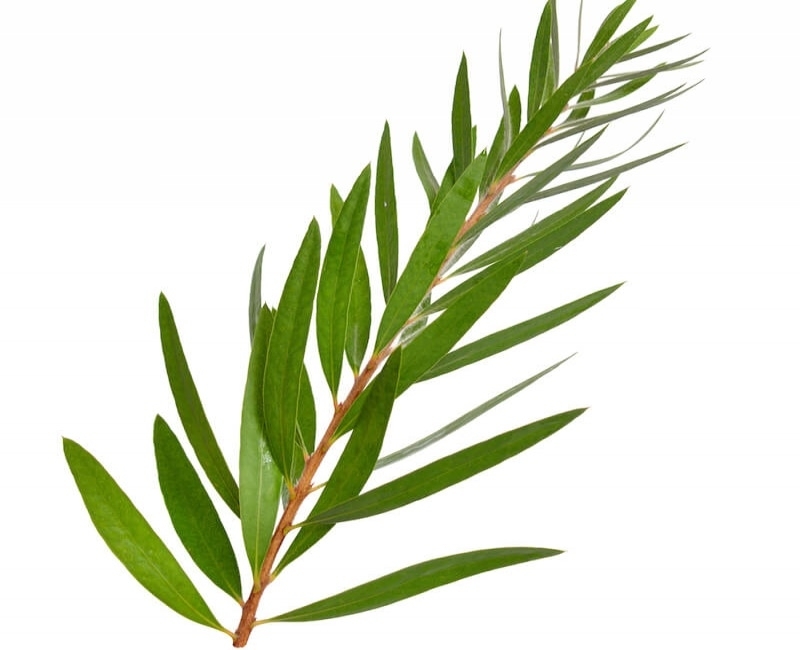TEA TREE OIL

OVERVIEW
Tea tree essential oil, also known in other countries as melaleuca oil or ti tree oil, is extracted from the leaves of the Melaleuca alternifolia, or tea tree. The tree is endemic only to the Northeast coast of New South Wales and in Southeast Queensland, Australia. The first extraction of tea tree essential oil occurred in Australia, with leaves from Melaleuca alternifolia. This species remains to be the most commercially important species in tea tree oil production. These native Australians crush tea tree leaves to extract the oil, which is then inhaled to treat coughs and colds or applied directly to the skin for healing. Tea tree oil has been used as a traditional medicine by Aborigines for centuries.
Today, tea tree oil is widely available as a 100% undiluted or "neat" oil. Diluted forms are also available, ranging from 5–50% strength in products designed for the skin. Oil of tea tree is now used commonly worldwide for its broad-spectrum antimicrobial properties. Therefore, it is available in different dosage forms for treating many infectious diseases. Tea tree oil contains various mono and sesquiterpenes as well as aromatic compounds. The monoterpenes terpinen-4-ol, γ-terpinene, α-terpinene, 1,8-cineole, pcymene, α-terpineol, α-pinene, terpinolenes, limonene and sabinene account for about 90% of the oil. It is argued that the monoterpenes , terpinen-4-ol, γ-terpinene and linalool are responsible for the antimicrobial activity of Tea tree oil.
APPEARANCE
Colourless to pale yellow liquid
ODOUR
Spicy, warm, terpenic, slightly herbaceous odour
ORIGINAL PLANT
Melaleuca alternifolia
CAS NUMBER
68647-73-4; 85085-48-9
FEMA NUMBER
3902
EINECS NUMBER
285-377-1
PRODUCT CODE
AFE003023
SYNONYM
Narrow-Leaved Paperbark, Narrow-Leaved Ti-Tree
PARTS USED
Leaves
EXTRACTION METHOD
Steam Distillation
SHELF LIFE
24 Months
FLASHPOINT
57°C
SPECIFIC GRAVITY
0.885-0.906 @ 20°C
REFRACTIVE INDEX
1.475-1.482 @ 20°C
QUALITY
100% Pure and Natural
SOLUBILITY
Insoluble in Water; soluble in alcohols
PROVIDES SKIN BENEFITS
The antiseptic properties of tea tree oil may contribute to its ability to combat oily skin. The anti-inflammatory properties of tea tree oil make it useful in relieving the discomfort of itchy skin. It soothes the skin and can also help heal infections that cause itchy skin. Tea tree oil is a popular choice for treating acne because of its anti-inflammatory and antimicrobial properties. It’s thought to calm redness, swelling, and inflammation. It may even help to prevent and reduce acne scars, leaving you with smooth, clear skin.
FIGHT BACTERIAL, FUNGAL AND VIRAL INFECTIONS
Tea tree oil can be used to fight a number of infections, from MRSA to athlete’s foot. It can inhibit the growth of bacteria like Pseudomonas aeruginosa, Escherichia coli, Haemophilus influenza, Streptococcus pyogenes and Streptococcus pneumonia. These bacteria cause serious infections, including pneumonia, urinary tract infections, respiratory illness, bloodstream infections, strep throat, sinus infections and impetigo.
HELP TREAT LICE
Tea tree oil has insecticidal effects and can be used to get rid of head lice, which are small, parasitic insects that feed on human blood. Tea tree oil with lavender has a fairly remarkable track record in ridding hair of lice.
IMPROVE BAD BREATH
Bad breath comes from bacteria that is found in your mouth, especially the back of your tongue, throat and tonsils. Because tea tree oil has antimicrobial properties that can kill this bacteria, it works as a natural remedy for bad breath. It decreases the bacterial colonies that cause halitosis, making it beneficial for oral health.
OTHER BENEFITS
Tea tree works as a natural treatment for scabies because it has powerful antimicrobial properties, it has antimicrobial activity, giving it the ability to fight bacteria that lead to nasty respiratory tract infections.







